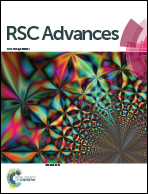A novel hydrolytic reaction to morphology-controlled TiO2 micro/nanostructures for enhanced photocatalytic performances†
Abstract
Different TiO2 micro/nanostructures have been hydrothermally prepared through controlling the hydrolysis and nucleation rate of Ti4+ ions by urea and H2O2 in a (NH4)2TiF6 aqueous solution. Anatase TiO2 nanorods with diameters of 10–30 nm and lengths up to 300–500 nm were evolved from the intermediate monoclinic H2Ti5O11·3H2O in the presence of H2O2 and urea, whereas TiO2 core–shell nanospheres with diameters of 300–500 nm were obtained with the sole assistance of urea via the Ostwald ripening effect and TiO2 microspheres with diameters of about 1–2 μm were formed in the presence of only H2O2. Photocatalytic degradation of Rhodamine B (RhB) has been used to evaluate their activities. The results indicate that the anatase TiO2 nanorods have superior photocatalytic efficiency to the core–shell nanospheres and microspheres counterparts owing to their larger specific surface area and higher yield of ˙OH radicals. This work not only offers a simple and promising route to the controllable synthesis of various TiO2 architectures, but also provides new insight for improving the photocatalytic performance of TiO2 through morphological engineering, which will have potential applications in environmental remediation.


 Please wait while we load your content...
Please wait while we load your content...